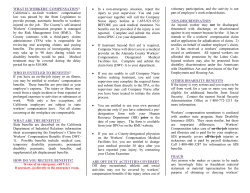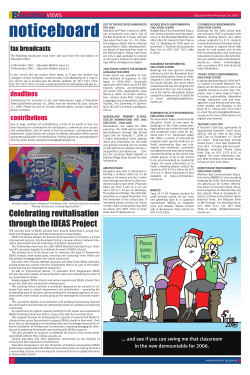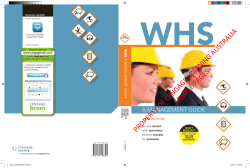
Compliance at a glance
Department of Justice and Attorney-General Workplace Health and Safety Queensland Serious about safe business? Compliance at a glance—How do you rate? Management commitment Consultation Safe work procedures Safe business is good business Training and supervision Reporting safety Workers’ compensation and return to work Rating Manager/s and worker safety responsibiIities clearly understood and acted on. Time and money allocated to meet safety responsibiIities. Manager/s promote safety as a high priority. Manager/s involved in all safety initiatives. Manager/s lead by example. Agreed consultation arrangements are used to discuss safety issues and are working effectively. Workers are involved in developing safe work procedures and making safety decisions. Workers’ views are valued and taken into account. All tasks with safety risks have been identified and the risks controlled. Safe work procedures developed and implemented for these tasks. Workers involved in developing safe work procedures. Procedures followed in dayto-day operations. Safe work procedures are reviewed. All workers inducted. Workers trained in safe work procedures before commencing tasks. Workers understand procedures and can demonstrate how to perform tasks safely. Workers are supervised to ensure safe work procedures are followed. Procedures for reporting safety issues and incidents are developed and implemented. Safety issues and incidents are reported and acted on, including notifications required by law. Safe work procedures and training reviewed following incident reports. Workers’ compensation insurance policy accurately reflects business details. All injuries are reported to workers’ compensation insurer. Workers informed of the return to work policy, including procedures to follow the event of an injury or illness. Return to work plans implemented for injured workers when required. Each tick in the green zone means you are more likely to be compliant. Monitor and review to continually improve. Safety responsibilities identified but not understood or operating effectively. Insufficient time and money allocated to meet safety responsibilities. Safety not always a priority. Limited involvement of manager/s in safety initiatives. Manager/s do not always lead by example. Consultation arrangements in place but not working effectively. Workers not always involved in safety decisions and developing procedures. Workers’ views not always valued or taken into account. Only some tasks with safety risks have been addressed. Limited development and implementation of safe work procedures. Limited involvement of workers in developing safe work procedures. Procedures developed but not always followed in dayto-day operations. Induction and training in safe work procedures incomplete or inconsistently applied. Some workers not able to demonstrate they can perform work tasks safely. Supervision does not always result in safe work procedures being followed. Reporting procedures developed but not always followed. Some incidents reported, but follow-up action limited. Safe work procedures and training not always reviewed following an incident report. Workers’ compensation insurance policy does not accurately reflect business details. Not all injuries reported to workers’ compensation insurer. Workers not aware of return to work policy, or procedures to follow if injured at work. Return to work plans are not effective in supporting injured workers to return to work. Each tick in the orange zone means you are increasing your level of compliance. But you still have work to do. No clear understanding of safety responsibilities. No time or money allocated to meet safety responsibiIities. Safety not a priority. No safety initiatives. Manager/s set a poor safety example. No consultation arrangements in place. No involvement of workers in safety issues. Workers’ views not valued or taken into account. Tasks with safety risks not identified nor the risk controlled. No safe work procedures developed. Safe work procedures not reviewed. Responsibility for doing tasks safely is left to workers. Workers not inducted. No safety training provided. Workers’ ability to perform tasks safely is not checked. Ability of workers to perform tasks safely is not checked. No supervision to ensure workers are performing tasks safely. No reporting procedures. Incidents not reported. No review of work practices following an incident. No workers’ compensation insurance policy. No return to work policy or procedures or plans. Workers not assisted to return to work after an injury. Each tick in the red zone means you are less likely to be compliant. ADDRESS THESE AREAS IMMEDIATELY. 1 Tick the boxes that most apply to you. 2 How did you rate? There is a range of products and services that can help you improve your work health and safety. Please view the Serious about safe business advice sheets. Introduction The Serious about safe business pack contains tools to help you identify what you need to do to make your workplace safer – and outlines how to do it. The pack is a practical approach to help you achieve compliance and involves: Management commitment – clearly define your own responsibilities and those of your workers; provide the resources to meet those responsibilities; get involved. Consultation – involve your workers when identifying and resolving safety issues. Safe work procedures – identify the tasks that can pose a risk to your workers, take action to control the risks, develop simple procedures to manage any tasks where risks cannot be fully controlled. Training and supervision – train your workers in the safe work procedures and ensure the procedures are followed at all times. Reporting safety – have a process for reporting safety issues, such as hazards and incidents, and ensure you act on these reports. Workers’ compensation and return to work – ensure your workers are covered by a workers’ compensation insurance policy and have an injury notification system and a return to work program to assist your injured workers. STEP 1 – How do you rate? Use the ‘Compliance at a glance’ checklist to determine how you rate and understand what you need to do to improve safety in your workplace. STEP 2 – How do you improve? The tools enable you to address issues that you identify in any of the above areas, and provide useful assistance whether you are starting from scratch or need only build upon what you already have in place. When using these tools, consider the following: •The best way to identify and resolve safety issues in your workplace is to involve your workers, and it is essential to have a clear understanding of each other’s responsibilities – as a first priority, address the issues in the advice sheets on management commitment and consultation. •Together with your workers, prioritise those tasks that need to be addressed to improve workplace safety and develop realistic timeframes for their completion based on the complexity of the task and the available resources. •Implementation of safe work procedures involves training your workers to ensure they understand the procedures and perform them correctly – and supervising your workers to ensure they always follow procedures. For more information Queensland’s work health and safety and workers’ compensation services worksafe.qld.gov.au Call us on 1300 362 128 Queensland business and industry portal www.qld.gov.au/business Including: •Australian Business Licence and Information Service •Australian Business Account Department of Tourism, Major Events, Small Business and the Commonwealth Games www.dtesb.qld.gov.au STEP 3 – Where can you get more assistance? There is a range of additional services that can assist you to work through this process. Contact Queensland’s work health and safety and workers’ compensation services for more information. DISCLAIMER: The materials presented in this publication are distributed by the Queensland Government as an information source only. The information and data in this publication are subject to change without notice. The Queensland Government makes no statements, representations, or warranties about the accuracy or completeness of, and you should not rely on any information contained in the publication. AEU 14/5160 This document is guidance material only and must be read in conjunction with the Work Health and Safety Act 2011, relevant Regulation and Codes of practice. The Queensland Government disclaims all responsibility and all liability (including without limitation liability in negligence) for all expenses, losses, damages and costs you might incur as a result of the information being inaccurate or incomplete in any way, and for any reason.
© Copyright 2025





















